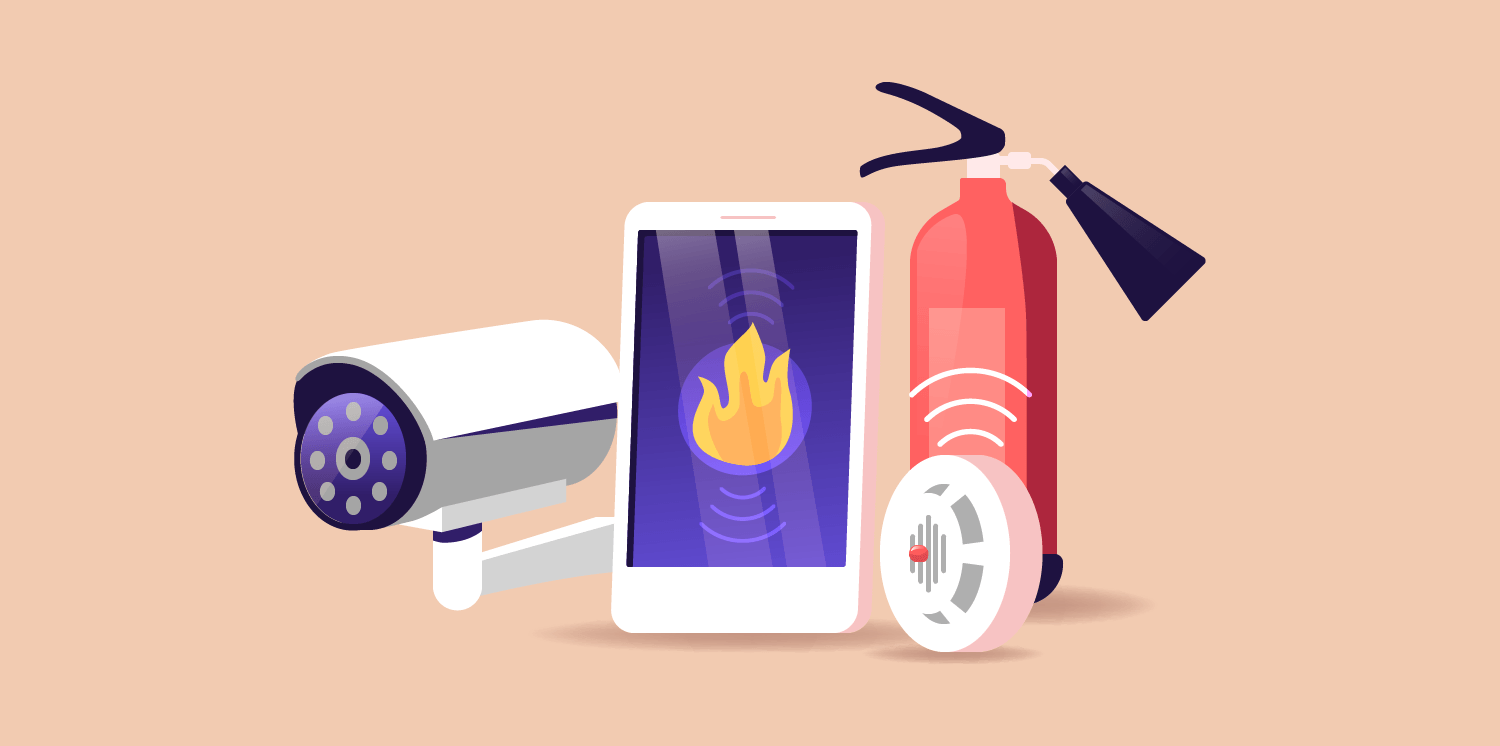From Forests to Urban Areas: AI Cameras for Comprehensive Wildfire Detection
ALCHERA
September 7, 2023
September 7, 2023
The Watchful Eye: How AI Cameras Are Transforming Wildfire Detection in Forests and Urban Areas
Table of Contents
Understanding the Role of AI in Wildfire Detection
- How AI cameras work for wildfire detection
- The role of machine learning in wildfire detection
- Comparison of AI wildfire detection methods with current technologies
AI Wildfire Detection Cameras in Forests: The First Line of Defense
- Role of AI cameras in monitoring forests and early wildfire detection
- Advantages and challenges of AI cameras in forest areas
- A successful implementation of AI wildfire detection cameras in real life: FireScout
Wildfire Detection Cameras in Urban Areas: Extending the Safety Net
The Synergy of AI Wildfire Cameras with Other Technologies
Looking Forward: The Future of AI Cameras in Wildfire Detection
- Potential advancements and improvements in AI camera technology
- Broader applications and possibilities for AI in managing and preventing wildfires
- The ethical considerations and potential societal impact of widespread AI camera implementation

Our planet is no stranger to the destructive force of wildfires, which obliterate ecosystems, destroy homes, and claim lives every year. The magnitude and frequency of these catastrophic events are escalating, making them a grave concern. In our battle against this burgeoning threat, technology, specifically artificial intelligence (AI), has emerged as a crucial ally. Early detection of wildfires is the key to mitigating their devastating effects, and AI promises to redefine this sphere significantly.
This article explores the transformative role of AI cameras in wildfire detection, their deployment in diverse environments ranging from dense forests to bustling urban areas, their integration with other cutting-edge technologies, and a glimpse into what the future might hold in this field.
Understanding the Role of AI in Wildfire Detection
As we increasingly turn to technology to solve some of our most pressing problems, artificial intelligence (AI) has emerged as a potent tool in the realm of wildfire detection. AI cameras, in particular, have shown immense potential in recognizing early signs of wildfires, promising a new level of proactive threat management.
How AI cameras work for wildfire detection

At their core, AI cameras are visual detection systems imbued with artificial intelligence capabilities. These smart systems use high-resolution sensors and advanced AI algorithms to continuously monitor their surroundings for signs of wildfires.
These signs could include the emergence of smoke, the presence of flames, or certain heat signatures that deviate from the norm. Once an AI camera captures visual data, it is analyzed by machine learning algorithms that have been trained to recognize these early signs of a wildfire. This data is then processed, and if the algorithm deems there is a sufficient risk of a wildfire, it triggers an alarm.
An essential aspect of these AI cameras is that they are designed to operate both day and night, ensuring continuous surveillance. Furthermore, they can cover large areas, thereby improving the chances of detecting a fire in its nascent stage, regardless of location.
Read more about the types of AI wildfire technologies and how they work in our previous post: AI and Robotics: Exploring Cutting-Edge Technologies for Wildfire Prevention
The role of machine learning in wildfire detection
The efficacy of AI cameras in detecting wildfires is significantly tied to machine learning. Machine learning is a subset of AI that enables computers to learn from data and improve their performance over time without being explicitly programmed.
In the context of AI cameras for wildfire detection, machine learning algorithms analyze vast amounts of data, learning to distinguish between a potential fire and benign environmental elements. For example, they need to differentiate between smoke from a fire and mist or fog. These distinctions are crucial to minimize false alarms and ensure that resources are mobilized accurately and efficiently.
Over time, as the algorithms are exposed to more data, their prediction accuracy improves. They learn to recognize the specific visual patterns that indicate a fire, making them increasingly effective at early detection.
Comparison of AI wildfire detection methods with current technologies
Traditional methods for wildfire detection have been largely reliant on satellites, ground patrols, and lookout towers. Each of these methods has strengths and limitations.
Satellite monitoring provides a global perspective but can be affected by cloud cover and doesn't always offer the resolution required for early fire detection. Ground patrols can be effective but are labor-intensive and limited by the range that individuals can cover. Lookout towers, while offering a broad view, are confined to a fixed location and depend on human vigilance, which can wane over extended periods.
In contrast, AI cameras provide a more constant, scalable, and efficient solution. Their ability to learn and improve, combined with their capacity for continuous monitoring, positions them as a powerful tool in wildfire detection. They do not replace the current methods; rather, they complement them, forming part of a more comprehensive and multi-faceted approach to managing wildfires.
We dedicated a whole post to the comparison of AI and traditional wildfire prevention methods. Check it out: AI vs. Traditional Methods for Wildfire Prevention: Which Is More Effective? https://alchera.ai/en/meet-alchera/blog/why-ai-is-better-than-traditional-wildfire-prevention-methods
AI Wildfire Detection Cameras in Forests: The First Line of Defense
In the expansive wilderness of forests where human monitoring is constrained, AI cameras offer an invaluable solution. They serve as our first line of defense, providing crucial early warnings that can significantly reduce the devastating impact of wildfires.
Role of AI cameras in monitoring forests and early wildfire detection
AI cameras are like tireless sentinels, continuously monitoring vast swaths of forests for any signs of fire. As they're designed to detect even the subtlest indicators of wildfires, such as faint plumes of smoke or unexpected heat signatures, they offer the potential for a rapid response. The speed and efficiency of this technology in raising alerts can mean the difference between a small, controllable fire and a large-scale disaster.
Real-time monitoring
-
Around-the-clock surveillance: Unlike human patrols, AI cameras can monitor forests 24/7, ensuring that no potential threat goes unnoticed.
-
Processing vast data: Equipped with AI, cameras analyze countless images in real time, quickly identifying any anomalies that could indicate the start of a fire.
Enhanced detection capabilities:
-
Smoke recognition: Even before flames become visible, AI cameras can detect the first signs of smoke, enabling quicker response times.
-
Thermal imaging: Some AI cameras come with infrared sensors, allowing them to detect heat sources that might be obscured by thick foliage or darkness, further enhancing early detection capabilities.
-
Pattern recognition: AI algorithms can distinguish between typical forest movements (e.g., animal activity) and anomalies, reducing false alarms.
Predictive analysis
-
Analyzing environmental factors: By assessing factors such as humidity, wind speed, and temperature, AI cameras can help in identifying areas that are at a higher risk of fires.
-
Data collection over time: Over prolonged use, AI cameras accumulate data, helping in understanding patterns, seasonal changes, and high-risk periods, enabling a more proactive approach.
Integration with broader systems
-
Alert mechanisms: Once a potential threat is identified, AI cameras can automatically alert authorities, ensuring rapid response.
-
Collaborative network: AI cameras can be integrated with other technologies, such as satellite imagery and drone surveillance, creating a comprehensive monitoring network that provides different vantage points and scales of observation.
Cost-effective monitoring
-
Reduced manpower costs: AI cameras reduce the need for round-the-clock human surveillance, making forest monitoring more cost-effective.
-
Long-term savings: Early detection and rapid response can significantly reduce the costs associated with extensive firefighting operations and the rehabilitation of burned areas.
Advantages and challenges of AI cameras in forest areas
There are several advantages to deploying AI cameras in forests. First, they can cover large territories with ease, enabling continuous monitoring of areas that might be inaccessible or hazardous for humans. Second, their constant vigilance ensures that potential fires are detected at the earliest possible stage.
However, there are also challenges to be considered. Forest environments can be unpredictable and harsh, with weather conditions such as heavy rain, wind, or snow potentially affecting camera operations. Additionally, powering and maintaining these devices in remote locations can be a logistical challenge. Ensuring reliable data transmission from dense forest areas is another technical hurdle that needs to be addressed.
A successful implementation of AI wildfire detection cameras in real life: FireScout

FireScout, a product developed by ALCHERA, is a prime example of how artificial intelligence can be applied to critical, real-world issues. This AI-powered smoke and fire detection system has been designed to identify early signs of wildfires, enhancing our ability to respond swiftly and effectively.
What makes FireScout unique? Its ability to analyze millions of images in real time around the clock, its low false-positive rate, and its high accuracy, a feat made possible by its access to a robust dataset from a network of one thousand fire watch cameras, as well as its integration with ALCHERA's advanced AI engine.
FireScout's approach stands apart, focusing on the seamless integration of existing infrastructure. Rather than relying solely on specialized AI cameras, the system is designed to connect with various monitoring cameras and ALCHERA's AI engine server through a network. This is facilitated by a SaaS-based model, which not only makes it compatible with a wide range of camera setups, including existing CCTV cameras, but also ensures swift and hassle-free implementation.
The system boasts features such as night mode, leveraging infrared (IR) cameras for enhanced visibility in low-light conditions. Moreover, FireScout goes beyond basic smoke detection. It incorporates a smoke direction estimation feature, enhancing its efficiency in enabling rapid responses. This real-time data transmission enables operators to accurately assess the direction of smoke and take necessary actions promptly.
One of FireScout's key strengths is its ability to seamlessly integrate into any existing emergency response process. Its cloud-based SaaS model allows it to connect with various camera types without the need for extensive on-site installation or complicated setups. This adaptability and ease of integration empower emergency response teams to make use of their current infrastructure while enhancing their capabilities with state-of-the-art AI-powered wildfire detection.
The success story of FireScout goes beyond its technical capabilities. In various forest regions where it has been deployed, FireScout has demonstrated its efficacy by enabling rapid responses to fires, effectively limiting their spread and potentially saving millions in damages. Additionally, its contribution to reducing the ecological impact of wildfires underscores the crucial role that AI technology like FireScout plays in safeguarding our forests and communities.
Read more about how AI fire detection helps humans preserve the planet here:
- Preventing Wildfires: Protecting Our Communities and the Environment
- Climate Change and Greenhouse Gas Emissions: How AI Helps Humans to Combat the Catastrophe
FireScout's impact continues to grow, serving as a testament to the potential of AI-driven solutions in addressing real-world challenges. As technology evolves and AI systems become more sophisticated, the story of FireScout's success will likely inspire further innovations in the field of wildfire detection and response.
Wildfire Detection Cameras in Urban Areas: Extending the Safety Net
Urban areas that border forests or are prone to fires present unique challenges and risks. There is a significant need for efficient wildfire detection systems in these urban-forest interfaces, often termed the Wildland-Urban Interface (WUI). The denser population and higher property values in these zones can escalate the potential damage and losses due to wildfires.
The WUI regions are where the built environment blends with natural terrain, which can often lead to catastrophic losses due to wildfires. As global warming intensifies and urban areas continue to expand into fire-prone regions, the need for sophisticated wildfire detection systems like FireScout in urban areas is more critical than ever.
A system like FireScout can offer early wildfire detection, enabling faster response times, mitigating fire damage, and potentially saving lives. Its AI-powered detection system can analyze vast amounts of data from surveillance cameras, detect signs of wildfires in their early stages, and alert emergency services in real time, making it an ideal solution for such high-risk areas.
Implementing FireScout or similar AI wildfire detection systems in urban settings will require some specific considerations and adjustments. These might include:
-
Camera placement: In urban areas, cameras need to be strategically placed to cover high-risk zones, considering the density and height of buildings and surrounding vegetation.
-
Integration with urban infrastructure: The system must be able to seamlessly integrate with existing urban surveillance systems and emergency response processes.
-
Handling increased data volume: With potentially higher numbers of cameras in densely populated areas, the system must be capable of managing and analyzing a more significant amount of data effectively.
-
Adaptation to urban fire characteristics: Urban fires might exhibit different characteristics from forest fires, like varied smoke colors or smaller ignition sources. The AI system must be trained to recognize these variations.
By addressing these factors, we can extend the safety net provided by AI wildfire detection systems to protect urban areas that are increasingly at risk of wildfire incidents. The goal is to harness the power of AI not only for forest fire detection, but also for safeguarding our cities and communities.
The Synergy of AI Wildfire Cameras with Other Technologies
The integration of AI cameras with other advanced technologies can create a comprehensive and highly effective wildfire detection system. Technologies such as satellite imagery and drone surveillance can complement AI cameras, creating an intricate network that covers different vantage points and scales of observation.
AI cameras serve as the frontline in real-time wildfire detection, continuously monitoring areas and offering immediate detection of fires. Their high-resolution, close-range data feed is essential for early detection, and their AI capabilities enable efficient processing of massive volumes of data.
On the other hand, satellite imagery provides a broader view, allowing for the monitoring of large, often inaccessible areas. It can capture thermal anomalies indicating wildfires, even under smoke or cloud cover. When integrated with AI, these images can be rapidly analyzed for potential fire hotspots.
Drones add a flexible, mobile dimension to wildfire detection. They can reach and closely monitor areas where stationary cameras or satellites might have limited visibility, such as steep terrains or dense forests. Equipped with thermal imaging and AI capabilities, drones can detect and track the progression of fires effectively.
Combining these technologies forms a layered, multi-faceted approach. AI cameras provide localized, high-resolution data; satellites offer wide-scale, continuous monitoring; and drones add mobility and flexibility. This synergy allows for comprehensive wildfire detection, from the initial spark to tracking a fire's spread and intensity.
Looking Forward: The Future of AI Cameras in Wildfire Detection

As we peer into the future, it's evident that AI cameras hold great potential in the realm of wildfire detection and management. Further advancements in AI and related technologies promise even more robust and effective solutions.
Potential advancements and improvements in AI camera technology
AI cameras, with their ability to analyze and learn from vast amounts of data, will undoubtedly see continuous improvements in terms of accuracy and efficiency. More advanced AI algorithms could further reduce false positives and increase the sensitivity of smoke and fire detection.
Moreover, we could see improvements in the hardware of AI cameras, with better visual and thermal sensors providing higher resolution imagery, even under challenging conditions such as low light or dense smoke. Increased automation, combined with improved AI algorithms, could allow systems to predict the potential spread and intensity of detected wildfires, aiding in more proactive and effective fire management.
Broader applications and possibilities for AI in managing and preventing wildfires
Beyond detection, AI has the potential to transform our approach to wildfire management and prevention. AI algorithms could be used to analyze historical fire data along with current environmental and weather data to predict high-risk areas and times for wildfires, aiding in prevention efforts.
In terms of fire management, AI could assist in modeling the spread of wildfires, considering factors such as terrain, vegetation, and weather. This would allow firefighters to strategize more effectively and allocate resources where they are most needed.
Furthermore, AI could play a role in post-fire recovery, analyzing satellite and drone imagery to assess damage and prioritize restoration efforts.
The ethical considerations and potential societal impact of widespread AI camera implementation
While AI cameras promise many benefits, their widespread implementation also raises important ethical and societal considerations. Concerns around privacy and surveillance may arise, particularly in urban settings, necessitating clear regulations around data use and privacy protections.
Moreover, considerations around equitable access to these technologies and their benefits are also critical. How can we ensure that all communities, including under-resourced ones, can benefit from this technology? Who will bear the costs of installing, maintaining, and monitoring these systems? These are questions that policymakers and society will need to address as we move towards more extensive adoption of AI cameras for wildfire detection.
The future holds exciting potential for AI cameras in wildfire detection and management, promising significant advancements and broader applications. However, it also demands careful consideration of the ethical and societal implications of these technologies.
...
...

